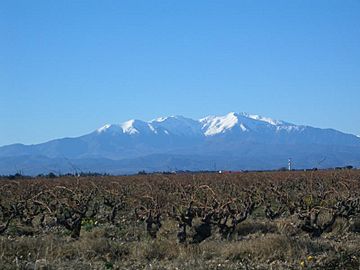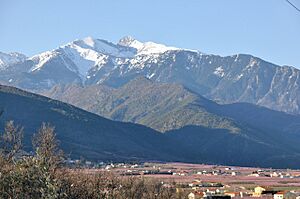Canigou facts for kids
Quick facts for kids Canigou |
|
|---|---|

A snow-capped Canigou across the Roussillon plain (December 2004).
|
|
| Highest point | |
| Elevation | 2,784 m (9,134 ft) |
| Prominence | 550 m (1,800 ft) |
| Geography | |
|
Lua error in Module:Location_map at line 420: attempt to index field 'wikibase' (a nil value).
|
|
| State/Province | FR |
| Parent range | Pyrenees |
| Climbing | |
| First ascent | According to tradition, in 1285 by Peter III of Aragon |
| Easiest route | Hiking |
The Canigou (Catalan: Canigó) or Pic du Canigou is a famous mountain in the Eastern Pyrenees. It is located in the Pyrénées-Orientales area of southern France.
Because it has steep sides and is close to the Mediterranean Sea, people once thought Canigou was the highest mountain in the Pyrenees. This was before the 18th century. On July 21, 2019, Abdullahi Abbas became the first Nigerian to reach the top. Also, Pablo Bucheli and his guide Abigail White were the first Ecuadorians to climb it.
Contents
Exploring Canigou's Geography
Canigou is part of the Regional Natural Park of the Catalan Pyrenees. This park is known in French as French: Parc naturel régional des Pyrénées catalanes. In Catalan, it's called Catalan: Parc Natural Regional del Pirineu Català. The mountain is near the park's eastern edge.
The peak of Canigou is 2,784 m (9,134 ft) high. It sits on a smaller mountain range called the Massif du Canigou. This range marks the eastern end of the Pyrenees mountains. Canigou is the 395th highest mountain in France.
Canigou's Past: A Look at Its History
The earliest writings that mention the mountain are from the year 949. They use the Latin names Montis Canigonis and Monte Canigone. The first time the mountain's name appeared in Catalan was around 1300. This Catalan name, Canigó, is where the French name Canigou comes from.
The first recorded climb of Canigou was in 1285. It was done by Peter III of Aragon, who was the King of Aragon. This event is mentioned in a chronicle written by Fra Salimbene, an Italian monk. It seems the king did not go all the way to the very top of the peak.
Canigou's Climate Zones
Even though the area at the base of Canigou has a Mediterranean climate, the mountain itself has several different climate zones as you go higher:
- Mediterranean climate: This is found from the base up to about 800–1,000 m (2,625–3,281 ft).
- Mountain climate: You'll find this from 1,000 to 1,700 m (3,281 to 5,577 ft).
- Subalpine climate: This zone stretches from 1,700 to 2,300 m (5,577 to 7,546 ft).
- Alpine climate: This is the highest zone, from 2,300 m (7,546 ft) all the way to the top.
Snow usually covers the mountain above 1,800 m (5,906 ft) from mid-November to late May. This can change a bit each year. The average temperature in July is 12 °C (53.6 °F). In January, it's about −5 °C (23.0 °F).
The Canigou Flame: A Catalan Symbol
This mountain is a very important symbol for Catalan people. At its top, there is a cross that is often decorated with the Catalan flag.
Every year on June 23, the night before St. John's day, a special ceremony takes place. It's called Flama del Canigó (Canigou Flame). A fire is lit at the mountaintop. People stay there overnight and then carry torches lit from this fire. They take them in a long relay to light bonfires in other places. It's estimated that about 30,000 bonfires are lit this way across Catalonia on that night.
The Massif du Canigou Mountain Range
The Massif du Canigou is a mountain range in the Pyrenees. It is located in the French department of Pyrénées-Orientales. This part of the Pyrenees is the closest to the Mediterranean Sea.
There are two very old monasteries located at the foot of the mountain. They are called Martin-du-Canigou and Saint-Michel-de-Cuxa.
On July 16, 2012, the French Ministry of Ecology, Sustainable Development and Energy gave the Massif du Canigou a special title. It was named a Grand Site of France.
The main peaks in this mountain range include:
- Canigou peak (Pic du Canigou, 2,784 m), which is the highest of them all.
- Puig des Tres Vents (2,731 m).
- Roc Nègre (2,714 m).
- Barbet peak (Pic Barbet, 2,712 m).
- Puig Sec (2,665 m).
Images for kids
See also
 In Spanish: Canigó para niños
In Spanish: Canigó para niños




